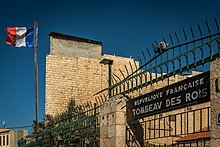Grave of Helene von Adiabene
The tomb of Helene von Adiabene (also tomb of the kings ) built around 50 AD during the reign of Emperor Claudius is the largest ancient tomb in Jerusalem . The building was mentioned several times in ancient times. According to sources, Queen Helene von Adiabene and two of her sons are said to have been buried here near the pyramids . She and her family converted to Judaism and then moved to Jerusalem, where they are said to have built several palaces.
The tomb is located north of what is now Jerusalem's Old City . Its forecourt, carved into the rock, was covered with hewn stones and sunk into the ground. A monumental staircase on the south side leads down to the forecourt. The entrance to the actual tomb on the west side has a staircase adorned with Ionic columns . There was a decorated lintel above the entrance. From there you get to a hall carved into the rock. To the south of it are rows of seven burial chambers with niches for burials in the walls. Above the facade of the entrance there were probably three temple-like buildings, each crowned by a pyramid. The pyramids are not preserved, but are known from ancient descriptions. Stones found during excavations were assigned to the pyramids. Several sarcophagi were found in the grave . One of them has a two-line inscription in two different Aramaic scripts and each with a different orthography: Queen Sadan (צדן מלכתא), Queen Sadah (צדה מלכתה). According to the general opinion, it should be Helene von Adiabene . Helene would be her Greek name, Sadan or Sadah her Semitic name. The inscription is on the front of the sarcophagus, which is otherwise decorated with two circles carved in the stone. The lid is gable-shaped. There is only one other inscribed sarcophagus from this era from Israel. Another sarcophagus from the tomb has four holes in the floor that were apparently used to drain body fluids.
The tomb was found in 1895 by the French explorer Louis Félicien de Saulcy (1807–1880), who referred to it as the Tomb of the Kings and suggested that kings of Judah were buried here. The grave was heavily robbed in ancient times. Some of the finds ended up in the Louvre .
Sarcophagus of Queen Sadah in the Louvre , said to be Helene von Adiabene
Web links
literature
- Ada Yardeni, Jonathan Price and Haggai Misgav: 123. Sarcophagus of Queen Ṣadan from the 'Tomb of the Kings' with Aramaic inscription, 1 c. CE. In: Hannah M. Cotton et al. a. (Ed.): Corpus Inscriptionum Iudaeae / Palaestinae . Volume 1: Jerusalem. Part 1, De Gruyter, Berlin 2010, pp. 165–167 (with detailed bibliography).
Individual evidence
- ↑ Flavius Josephus , Jüdische Antiquities 20, 17–95; Pausanias 8: 16, 4-5.
- ↑ Rachel Hachlili: Jewish Funerary Customs. Practices and Rites in the Second Temple Period (= Journal of the Study of Judaism. Supplement 94). Brill, Leiden / Boston 2005, ISBN 90-04-12373-3 , pp. 36-37.
- ↑ Helene, Queen of Adiabene
- ↑ Hachlili: Jewish Funerary Customs , pp. 300-301.
- ↑ Hachlili: Jewish Funerary Customs , pp 484-486.
- ↑ Louis Félicien de Saulcy: Voyage en Terre Sainte Volume I, Paris 1865, pp. 345-410 online
- ^ Queen Helene's sarcophagus on the Louvre website.





